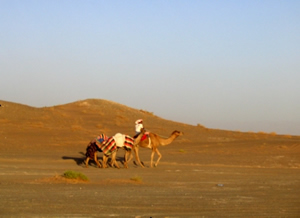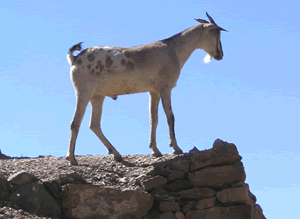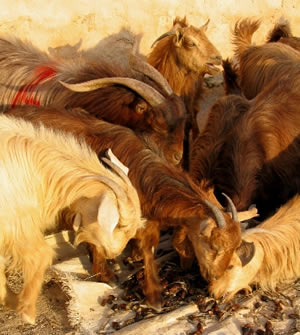Nomadism has existed since thousands of years. The herds follow the fodder and the herders follow the herds. It is a well-adapted lifestyle for arid and semiarid regions. The animals are the nomads’ “movable wealth”. Under nomadic conditions, certain skills and adaptation mechanism are requested by the animals. Among these specific requirements are the adaptation to water scarcity: Whereas cattle and sheep need to drink water every two to three days, goats can cope without water for four to five days. Camels can do so even for up to two weeks. Due to that, the grazing radius of camels and goats around a water source is much larger than that of cattle or sheep.
I. Goats
Goats fulfil many different functions in Oman. They are an important provider
of animal protein in the form of meat and milk. Especially selling the
meat is an important source of income to small holders, as goat meat is
the most preferred by the Omanis. On social and religious occasions it
is a custom to slaughter a goat.
“The goat is an ideal animal for keeping in harsh arid areas of
the world. Its ability to survive under such conditions and produce high
quality animal protein in the form of milk and meat is unparalleled except
probably by the camel. The ability of goats to achieve this is attributed
to their low body mass, low metabolic requirements, skilled behaviour
and efficient digestive system” (O. Mahgoub et al., Sultan Quaboos
University, 2004).
Three different breeds of goats are distinguished in Oman. They are named after the regions from which they originate: The Batina goat from the Al Batina plains, the Dhofari goat from the Dhofar region in the South of Oman and the Jebel Akhdar goat from the Jebel Akdar mountains in the North..
Traditionally, sacrificing a goat has a strong religious
meaning in Islam because it symbolizes Abraham´s son being saved
by God (and a goat being sacrificed instead of him). For instance, the
end of Ramadan is celebrated by slaughtering a goat.
Goat management is a part of Omani heritage and tradition. Goats used
to be an important factor in deciding dowries. Women played (and still
play) a major role in controlling the goats as well as taking decisions
with regard to this wealth.
Continue to "Camels".


